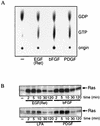Protein kinase B activation and lamellipodium formation are independent phosphoinositide 3-kinase-mediated events differentially regulated by endogenous Ras
- PMID: 9528752
- PMCID: PMC121410
- DOI: 10.1128/MCB.18.4.1802
Protein kinase B activation and lamellipodium formation are independent phosphoinositide 3-kinase-mediated events differentially regulated by endogenous Ras
Abstract
Regulation of phosphoinositide 3-kinase (PI 3-kinase) can occur by binding of the regulatory p85 subunit to tyrosine-phosphorylated proteins and by binding of the p110 catalytic subunit to activated Ras. However, the way in which these regulatory mechanisms act to regulate PI 3-kinase in vivo is unclear. Here we show that several growth factors (basic fibroblast growth factor [bFGF], platelet-derived growth factor [PDGF], and epidermal growth factor [EGF; to activate an EGF receptor-Ret chimeric receptor]) all activate PI 3-kinase in vivo in the neuroectoderm-derived cell line SKF5. However, these growth factors differ in their ability to activate PI 3-kinase-dependent signaling. PDGF and EGF(Ret) treatment induced PI 3-kinase-dependent lamellipodium formation and protein kinase B (PKB) activation. In contrast, bFGF did not induce lamellipodium formation but activated PKB, albeit to a small extent. PDGF and EGF(Ret) stimulation resulted in binding of p85 to tyrosine-phosphorylated proteins and strong Ras activation. bFGF, however, induced only strong activation of Ras. In addition, while RasAsn17 abolished bFGF activation of PKB, PDGF- and EGF(Ret)-induced PKB activation was only partially inhibited and lamellipodium formation was unaffected. Interestingly, in contrast to activation of only endogenous Ras (bFGF), ectopic expression of activated Ras did result in lamellipodium formation. From this we conclude that, in vivo, p85 and Ras synergize to activate PI 3-kinase and that strong activation of only endogenous Ras exerts a small effect on PI 3-kinase activity, sufficient for PKB activation but not lamellipodium formation. This differential sensitivity to PI 3-kinase activation could be explained by our finding that PKB activation and lamellipodium formation are independent PI 3-kinase-induced events.
Figures







Similar articles
-
Role of phosphoinositide 3-kinase in activation of ras and mitogen-activated protein kinase by epidermal growth factor.Mol Cell Biol. 1999 Jun;19(6):4279-88. doi: 10.1128/MCB.19.6.4279. Mol Cell Biol. 1999. PMID: 10330169 Free PMC article.
-
Signaling complexes and protein-protein interactions involved in the activation of the Ras and phosphatidylinositol 3-kinase pathways by the c-Ret receptor tyrosine kinase.J Biol Chem. 2000 Dec 15;275(50):39159-66. doi: 10.1074/jbc.M006908200. J Biol Chem. 2000. PMID: 10995764
-
Akt/protein kinase B isoforms are differentially regulated by epidermal growth factor stimulation.J Biol Chem. 2000 Oct 6;275(40):30934-42. doi: 10.1074/jbc.M004112200. J Biol Chem. 2000. PMID: 10908564
-
Will kinase inhibitors make it as glioblastoma drugs?Curr Top Microbiol Immunol. 2012;355:135-69. doi: 10.1007/82_2011_178. Curr Top Microbiol Immunol. 2012. PMID: 22015553 Free PMC article. Review.
-
Phosphoinositide 3-kinase inhibition in cancer treatment.Expert Opin Investig Drugs. 2001 Jun;10(6):1085-98. doi: 10.1517/13543784.10.6.1085. Expert Opin Investig Drugs. 2001. PMID: 11772237 Review.
Cited by
-
Protein kinase A-dependent and -independent signaling pathways contribute to cyclic AMP-stimulated proliferation.Mol Cell Biol. 1999 Sep;19(9):5882-91. doi: 10.1128/MCB.19.9.5882. Mol Cell Biol. 1999. PMID: 10454535 Free PMC article.
-
Protein kinase B/Akt participates in GLUT4 translocation by insulin in L6 myoblasts.Mol Cell Biol. 1999 Jun;19(6):4008-18. doi: 10.1128/MCB.19.6.4008. Mol Cell Biol. 1999. PMID: 10330141 Free PMC article.
-
Role of phosphoinositide 3-kinase in activation of ras and mitogen-activated protein kinase by epidermal growth factor.Mol Cell Biol. 1999 Jun;19(6):4279-88. doi: 10.1128/MCB.19.6.4279. Mol Cell Biol. 1999. PMID: 10330169 Free PMC article.
-
TGFβ-stimulated microRNA-21 utilizes PTEN to orchestrate AKT/mTORC1 signaling for mesangial cell hypertrophy and matrix expansion.PLoS One. 2012;7(8):e42316. doi: 10.1371/journal.pone.0042316. Epub 2012 Aug 3. PLoS One. 2012. PMID: 22879939 Free PMC article.
-
microRNA-21 governs TORC1 activation in renal cancer cell proliferation and invasion.PLoS One. 2012;7(6):e37366. doi: 10.1371/journal.pone.0037366. Epub 2012 Jun 4. PLoS One. 2012. PMID: 22685542 Free PMC article.
References
-
- Alessi D R, James S R, Downes C P, Holmes A B, Gaffney P R, Reese C B, Cohen P. Characterization of a 3-phosphoinositide-dependent protein kinase which phosphorylates and activates protein kinase B-alpha. Curr Biol. 1997;7:261–269. - PubMed
-
- Burgering, B. M. T., et al. Unpublished data.
-
- Burgering B M T, Coffer P J. Protein kinase B (c-Akt) in phosphatidylinositol-3-OH kinase signal transduction. Nature. 1995;376:599–602. - PubMed
Publication types
MeSH terms
Substances
LinkOut - more resources
Full Text Sources
Research Materials
Miscellaneous
